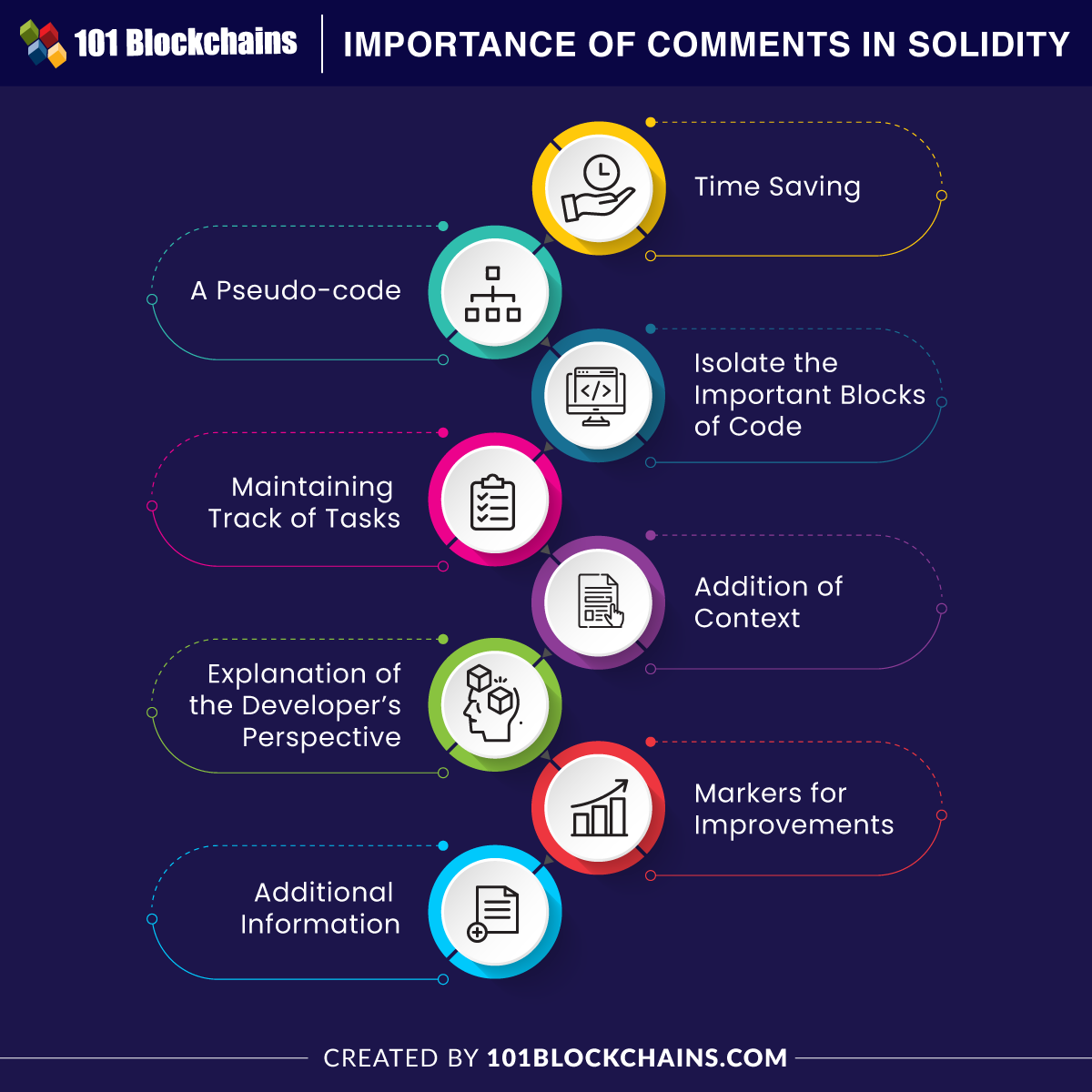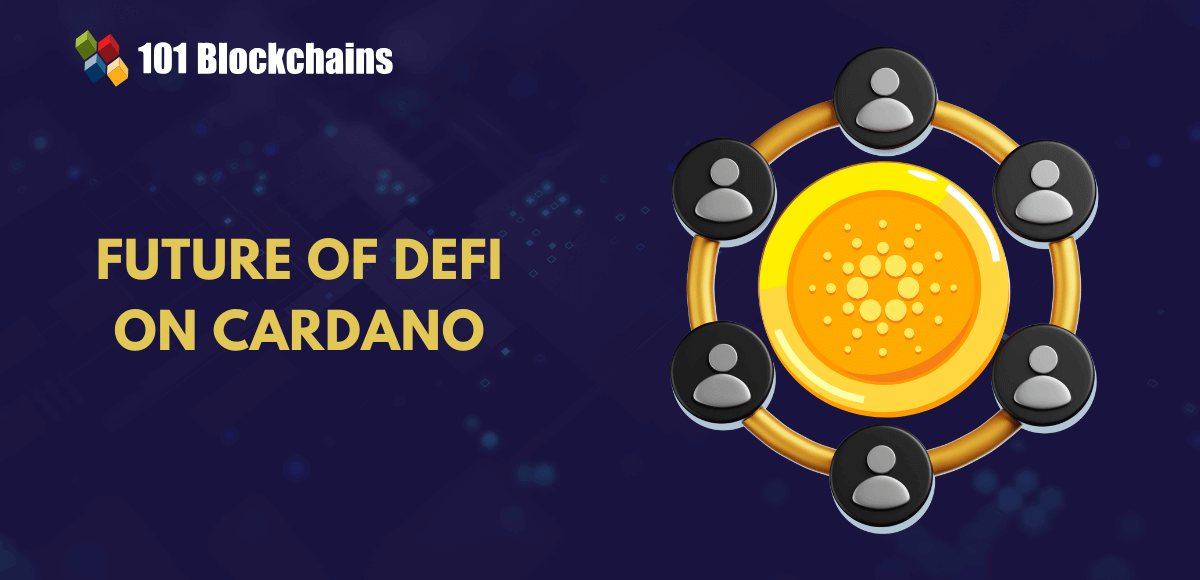Learn how blockchain truly works, master key definitions, and uncover what makes smart contracts so "smart." Dive into the fundamentals, gain valuable insights, and start your blockchain journey today!

- Solidity & Smart Contracts
Georgia Weston
- on August 05, 2022
What Are Comments In Solidity and Why It Is Important
Solidity is one of the most popular entries among programming languages for smart contract development. Many aspiring developers want to learn about the best practices for using the contract-oriented programming language. Therefore, the interest in Solidity comments is also one of the priorities for people interested in developing decentralized, smart contract-based applications. At the same time, it is also important to wonder about the reasons for learning about comments in Solidity and their importance.
The following discussion offers you a detailed introduction to comments in the Solidity programming language and its variants. You can learn about the benefits of comments in a programming language and the examples of documentation for comments with the Solidity programming language.
Are you aspiring to learn the fundamentals of the Ethereum Virtual Machine and smart contracts’ upgradability? Enroll now in the Advanced Solidity Development Course.
What are Comments?
Comments basically refer to a description for a specific line or block of code, which can help developers in a better understanding of the code. It is not only meant for developers but also to make the smart contract code readable for end users. The necessity of Solidity comments dev processes is important to understand the code in the first place. Even the developers can experience difficulties in understanding code without any comments. Therefore, comments are an integral part of any programming language, especially a critical choice like Solidity for developing smart contracts. On the other hand, there are many people who believe that comments are a redundant highlight in programming. Such schools of thought encourage simplifying the code for human understanding rather than writing comments to describe code.
Build your identity as a certified blockchain expert with 101 Blockchains’ Blockchain Certifications designed to provide enhanced career prospects.
Why Do People Avoid Comments?
When you are trying to learn the answers to “What are comments in Solidity,” you can find doubts about using comments. Your doubts may get stronger with the reasons suggested by people for avoiding comments in their Solidity code. Writing a simpler code is more of an alternative rather than an explanation to avoiding comments. What could be the possible reasons for which developers would avoid comments?
- One of the first reasons to show why Solidity comments dev processes are missing is the need for brainpower to write and maintain comments. It is difficult for many developers to explain the objective of an algorithm or function in simple comments after spending prolonged sessions debugging.
- The next important reason for which developers might choose to avoid comments in their smart contract code refers to the lack of skills. Solidity developers can experience challenges in explaining the intent and reasoning behind their code in simple English language. As a result, they tend to avoid comments as long as the code works fine.
- Another possible reason for avoiding comments in Solidity would refer to the limited understanding of underlying mechanics in specific portions of the code. You can identify that the lack of understanding about specific parts of the code could induce the inability to explain the concerned part of the code. Ultimately, developers find it quite cumbersome to write comments after extensive development and testing sessions, especially when they cannot understand how the code works from the inside.
The reasons for which people don’t comment on codes in Solidity show that lack of comments can ultimately land developers with critical problems at later stages. Solidity is an important programming language for smart scripting contracts and defining the code used for executing the contracts and decentralized application functionalities. Leaving out Solidity comments by subscribing to specific schools of thought cannot deliver any conclusive advantage to developers. On the contrary, developers must recognize the importance of comments in the functionalities of a programming language.
Learn the process of creating and deploying smart contracts on the Ethereum blockchain with the Solidity Fundamentals Course.
Importance of Comments in Solidity
The important aspect of the guide to comments on Solidity programming language would turn the limelight towards their significance. How do comments deliver any form of value for Solidity developers? Why are Solidity comments important, and how can they help developers? Here are some of the notable advantages of Solidity every smart contract developer should consider before using Solidity to create smart contracts.

-
Time Saving
The foremost benefit of adding comments in your Solidity programming code is time-saving. You can save a considerable amount of time by avoiding confusion about the reasons for which a specific portion of the code fails in the compilation. Developers can comment on their Solidity code and save time by identifying the working of the code quickly. The comments can also serve as useful guidance or benchmarks for future developers to make changes or improvements to the project.
-
A Pseudo-code
The addition of comments in Solidity programming language also serves as a type of pseudo-code. You can build your app around the pseudo-code with an understanding of the type of functions you want and where you should place them in your Solidity code. The comments can serve comprehensive insights regarding the mechanisms of a specific block of code.
-
Isolate the Important Blocks of Code
You can know ‘what are comments in Solidity’ and more about their importance on the grounds of isolating important blocks of code. Remember that Solidity programs might have specific portions which are integral to the functioning of the whole code. Any type of alterations in the concerned part could affect the outcomes of the code. Therefore, comments can help you avoid unwanted troubles in the future when you might have to upgrade the Solidity code. The warning comments for specific lines of code could help in avoiding unwanted changes which might affect the intent of the whole program.
-
Maintaining Track of Tasks
The functionalities of Solidity comments in the dev experience would also provide facilities for commenting within the code. It can help in discovering the subsequent tasks you need to achieve within your smart contract or decentralized application. The comments will help you stay in the right direction with a natural order of process flow.
-
Addition of Context
The work of comments in the Solidity programming language is not limited only to the explanation of content in the code. Comments show what a specific line of code means and its function. At the same time, comments also deliver clarity regarding the way a particular line or block of code works for the complete application. Basically, you can figure out the significance of the block of code in the overall smart contract or decentralized applications. With a simple and explicit description of functionalities, comments can ensure that you don’t have any confusion about deleting specific nodes.
-
Explanation of the Developer’s Perspective
The most significant reason for using Solidity comments refers to the clear glimpse of the developer’s perspective. Comments in the smart contract or decentralized application code written in Solidity can show why the developer has scripted the comments that way. Some of the methods used by Solidity developers in their code might not be clear to many. In such cases, the comments can help in understanding the reasons behind the developer’s choices. Furthermore, comments can help in understanding the reasons behind the working of a particular method in the code. You can also anticipate the reasons for which developers choose different methods than the recommended options.
-
Markers for Improvements
Another formidable reason for using Solidity comments in dev processes would refer to the access to bookmarks for improvement. If you are having trouble with a specific line of code, then you can mark it with a comment so that you can return back to it later.
-
Additional Information
The reasons for using comments in almost any programming language, especially Solidity, would also focus on adding extra information. Comments could serve a significant purpose in highlighting the title of the application or author of the software and, most important of all, the last date of update. Solidity developers can use comments as a flexible instrument for highlighting the last update date and the authority responsible.
The answers to “Why Solidity comments are important” offer a reflection of the credibility of developers. Comments show that you are prepared to travel the extra mile to make your code human-readable and understandable for everyone. By adding comments, Solidity developers can offer a guide on using the code in the present as well as in the future. Above everything else, comments on the Solidity code showcase the intent of developers behind creating the solution.
Types of Comments in Solidity
Any guide on Solidity comments would showcase a formidable impression of how they can help in improving code maintenance. At the same time, it is also important to learn about the different variants of comments you can find in Solidity. The two notable categories of comments in the documentation of Solidity refer to regular comments and NatSpec comments. Regular comments are further classified into a single line and multiline comments. It is also important to note that the compiler can ignore comments text and does not translate it into byte code as other parts of the code. Let us learn more about each type of comment in Solidity programming language.
Regular Comments
Regular comments are the common code comments you can use in Solidity for documentation of your code base. Such types of comments are considered useful for driving better understanding and maintenance of code base through other developers. The two popular types of regular comments refer to a single line or inline comments and multiline or block line comments. Here is an overview of the two types of regular comments and their general syntax example.
-
Single Line Comments
The single-line comments or inline comments are always added in the form of a new line or inline manner for the code. It is also important to identify that single-line comments must begin with a double forward slash symbol, i.e., “//,” and the text content would follow afterward. Here is the syntax example for adding a single-line comment in Solidity smart contracts.
// Single line comment example
-
Multiline or Block Line Comments
The multiline or block line comments are the next important category among regular comments in Solidity programming language. In the case of multiline comments, the text of the comments could cover multiple lines. They are also referred to as block-level comments. The method to writing Solidity multiline comments involves beginning with a “/*” and including the comment text in multiple lines. The comment ends with the “*/” annotation. You can take a look at the following syntax example to check how to write multiline comments
/* * * multiline comment line1 * multiline comment line2 */
Master the art of Smart Contract development with Solidity to create innovative web3 applications for diverse use cases as a Solidity expert with Solidity Skill Path
NatSpec Comments
The answers to “What are comments in Solidity” would also draw attention to the special form of comments evident in the form of NatSpec comments. Solidity smart contracts could leverage these special comments to facilitate comprehensive documentation for return variables, functions, and many other aspects. The NatSpec comments basically follow the Ethereum Natural Language Specification Format, and the design has been drawn from Doxygen. At the same time, Solidity comments don’t have to comply with the compatibility requirements for Doxygen. Developers have also recommended that Solidity contracts must feature complete annotation by leveraging the NatSpec format. In addition, it includes formats for comments that the smart contract author could use. The NatSpec format would also feature annotations leveraged by third-party tools. Developers can make the most of tags, which are optional although featuring multiple functions. The notable tags include the following mentions,
- @title
- @author
- @notice
- @dev
- @param
- @return
- @inherit
- @custom:
In addition, the NatSpec comments would use the Solidity compiler for processing NatSpec documentation from the Solidity source code.
Excited to learn the basic and advanced concepts of ethereum technology? Enroll Now in The Complete Ethereum Technology Course
Final Words
The details regarding the definition of comments and “why Solidity comments are important” showcase the significance of comments. Solidity is a popular choice for smart contract developers, especially considering the volume of decentralized applications on Ethereum. Comments are often perceived as a redundant highlight of the Solidity code, and some developers may find it tiresome to simplify their intent and purpose in plain English. However, comments serve a far more important role than explaining the objective and functions of different lines and blocks of code. Comments in Solidity are an essential requirement for tracking the progress of developing the concerned smart contract or decentralized application. In addition, comments can also help developers recognize the important blocks of code which should not be altered. Learn more about the Solidity programming language and how it can help smart contract developers.






